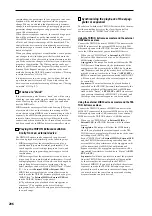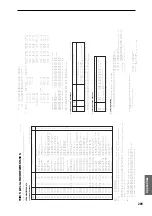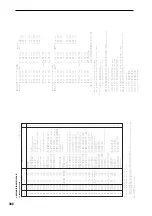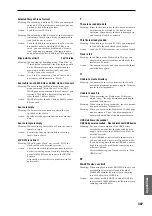
295
Appendices
About system exclusive messages
Since the way in which these messages are used is left up to
each manufacturer, they are mainly used to transmit and
receive sound data and editing data for parameters that are
unique to a particular instrument. The TRITON Extreme’s
system exclusive message format is [F0, 42, 3n, 50, ff, ..... F7]
F0:
exclusive status
42
: Korg ID
3n:
[n=0–F] global MIDI channel 1–16
50:
Future model ID
ff:
function ID (type of message)
–
...
F7:
end of exclusive
To obtain a copy of the “MIDI Implementation” which
includes MIDI exclusive format information, please
contact your Korg distributor.
Some USB-MIDI interface devices may not be able to
transmit/receive the TRITON Extreme’s MIDI exclu-
sive messages.
Universal system exclusive
Certain of the system exclusive messages are publicly
defined for a specific use, and these are called universal sys-
tem exclusive messages.
The TRITON Extreme uses the following six universal sys-
tem exclusive messages.
Inquiry message request [F0, 7E, nn, 06, 01, F7]
Inquiry message [F0, 7E, nn, 06, 02, (nine bytes), F7]
When an inquiry message request is received, the TRITON
Extreme will respond by transmitting an inquiry message
that means “I am a Korg TRITON Extreme, with system ver-
sion ...”
GM system on [F0, 7E, nn, 09, 01, F7]
When this message is received in Song Play mode, the TRI-
TON Extreme will be initialized for GM playback.
Master volume [F0, 7F, nn, 04, 01, vv, mm, F7]
(vv: lower byte of the value, mm: upper byte of the value,
together indicating 16384 steps)
This message is transmitted if you assign Master Volume as
the function of the ASSIGNABLE PEDAL or as a B-mode
function of a REALTIME CONTROLS [1]–[4] knobs and
operate the controller. This will adjust the overall volume
balance without changing the relative volume balance
between timbres/tracks. When this message is received, the
result will be the same as when the controller is operated.
Master balance [F0, 7F, nn, 04, 02, vv, mm, F7]
(vv: lower byte of the value, mm: upper byte of the value,
together indicating 16384 steps, where 8192 is the default
position, and lower values will move the sound toward the
left)
When this is received, the overall panning will be adjusted
without changing the relative panning between timbres/
tracks.
Master fine tuning [F0, 7F, nn, 04, 03, vv, mm, F7]
(A value of 8192 [mm, vv=40, 00] is center, 4096 [mm, vv=20,
00] is –50 cents, and 12288 [mm, vv=60, 00] is +50 cents.)
When this is received, the “Master Tune” (Global P0: 0–1a)
parameter will be set.
Master coarse tuning [F0, 7F, nn, 04, 04, vv, mm, F7]
(Normally only the upper byte mm is used. A value of 8192
[mm, vv=40, 00] is center, 6656 [mm, vv=34, 00] is –12 semi-
tones, and 9728 [mm, vv=4C, 00] is +12 semitones.)
When this is received, the “Transpose” (Global P0: 0–1a)
parameter will be set.
Transmitting sound settings data (Data Dump)
Data for programs, combinations, drum kits, user arpeggio
patterns, global settings, and sequencer data can be trans-
mitted as MIDI exclusive messages. The operation of send-
ing this system exclusive data to an external device is called
a “data dump.”
By performing a data dump, you can store the TRITON
Extreme’s sounds and settings on an external device, or
rewrite the sounds and settings of another TRITON
Extreme.
There are the following three types of data dump.
• When you use the “Dump” (Global P1: 1–1) page menu
command to dump data, various types of internal
memory data will be transmitted. If this data is received
by the TRITON Extreme, the data will be written directly
into internal memory, and it will not be necessary to
perform the Write operation. (“Transmission,”
“Reception”
• If the “Enable Exclusive” (Global P1: 1–1b) setting is
checked, selecting a combination in Combination P0:
Play will transmit data for one combination. Selecting a
program in Program Play P0: Play will transmit data for
one program.
This data is the edit buffer data for the currently selected
combination or program. If this data is received by the
TRITON Extreme, the data will be written into the edit
buffer, so if you wish to save it to internal memory, you
will need to perform the Write operation. The Write oper-
ation can also be performed by a MIDI exclusive Pro-
gram Write Request or Combination Write Request
message, in addition to the usual method of using the
TRITON Extreme’s switches. (“Writing to internal mem-
ory”
• If the “Enable Exclusive” (Global P1: 1–1b) setting is
checked, data will also be dumped in response to a
Dump Request message. This data is transmitted and
received on the global MIDI channel.
Editing sounds etc.
By using various MIDI exclusive data dumps, you can
rewrite all programs or an individual program. By using
parameter change messages, you can edit individual param-
eters as follows.
Parameter changes
• In Program mode, all parameters other than the program
name can be edited. Performance editor parameters are
included.
• In Combination mode, parameters other than the
combination name can be edited.
• Refer to p.102 for the parameters that can be edited in
Sequencer mode.
Drum kit parameter change/User arpeggio pattern
parameter change
• In Global mode, you can edit drum kits and user
arpeggio patterns.
Since the other global parameters or Sequencer mode musi-
cal data cannot be edited, you will use data dumps to trans-
fer this data. Data dumping of Sampling mode data is not
supported.
The global MIDI channel is used to transmit and receive this
data.
First check “Enable Exclusive” (Global P1: 1–1b), so that
exclusive data can be transmitted and received. When you
change modes on the TRITON Extreme, a mode change
message will transmitted. When you change programs or
Summary of Contents for TRITON Extreme
Page 1: ...2 E ...
Page 11: ...xii ...
Page 111: ...100 9 5 Page Menu Command 0 1A 0 1I 0 1J Program 9 5A ...
Page 185: ...174 ...
Page 215: ...204 ...
Page 281: ...270 ...
Page 349: ...338 ...
Page 350: ...339 ...
Page 351: ...340 ...
Page 352: ...341 ...
Page 353: ...342 ...
















































